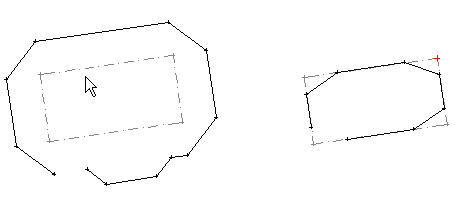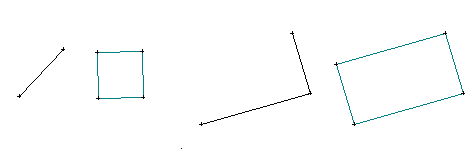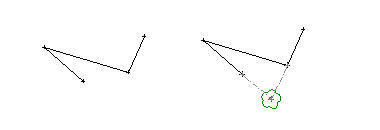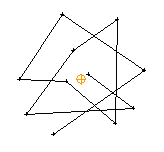
The idea is to measure a single line and convert that into several lines or points.
Code field T3 is used for coding. All instruments can produce this data.
A control file is needed to code definitions. One line has parameters for one group. Use semicolon to separate different parameters.
Group measurements can be used in format conversion (read file) by defining control file in special setting GroupFile. Conversion can also be done in Check file -function by pressing Groups-key.
No changes are needed is codefile (e.g. code_53.dat).
There are six different types:
code=line1, line2, ..., lineN; T1; Fx; Z0;
Maximum number of lines is 20. You can measure from left to rigth or vice versa, but one N-point group (one section) always the same way. Every section must have same number of points.
F4: only one point in group is measured. Other points are copied from the previous section.
Z8: reset height

code=line1, line2, line3; T2; Fx; H0.15; W0.20;
If you define only two lines (line3 not given), you only get the upper and lower line of the kerb.
The most simple way is to measure only the lower line. If height and/or width changes, you can measure points for new height and width.
N.B. if you measure the second point (height), it has to be measured on the same side where the stone is. This offset can be 0.1 - 0.5 m but the line will always ne 2 cm away from the lower line.
H stone height. Default 0.10 m.
W stone width. Default 0.20 m.

code=line1, line2; T3; Fx; Z0;
Use 8 points to measure the house either on wall line (F16) or outside the house. The line is closed automatically.
If the measured line has 12 points, there is a verandah (porch). This is measured last. Verandah can have a separate code. If no code is defined for lines2, verandah will get same code as the house.
If the measured line has 3 points, it will be closed as rectangle.
If the measured line has 2 points, parameters W and H can be used to define size of the rectangle. If H=0, rectangle length is same as line length.
F2: square by measuring the diagonal (electrical box).
F4: rectangle by measuring three corners (or a two point line).
Z8: reset height

A house measured outside and a house measured on wall line using 8 points.

A square measured using diagonal and a rectangel measured by three points.
code=line1; T4; Fx; Z0;
First and last points define a straigh line and the other points are moved on that line. The new point gets height from the measured point.
F2: store new points as single points.
Z2: height form the reference line (first-last), otherwise height fromn the measured point
Z8: reset height

code=line1; T5; Z0;
Measure four points which define two intersecting lines. The first two points define the first line and last two points second line. Height for the intersection point is extrapolated using the first two points.
Z2: height calculated as a mean value of the both lines, otherwise height from the first line
Z8: reset height

code=line1; T6; Fx; Dx;
If the measured line only has one group of points, point number is copied from the line number.
The same line can have several "separate" groups, if the distance between points bigger than the limit value (parameter D). In this case the new points are numbered from 1.
F4: use Sigma3-deviation to remove erroneous points. If X, Y or Z -coordiante differs from the mean value more than sigma3 (3-times mean deviation), point will not be used in mean value calculation.
D limit value for distance. If two consecutive points have a longer distance, a new group is started. Default = 0.0. All measured points used in same calculation.
Z8: reset height

code=line1; T7; Fx; Dx;
Ympyrän mittaaminen yhdellä, kahdella tai kolmella pisteellä.
F1: mittaa keskipiste ja kehäpiste.
F2: mittaa halkaisijan pisteet.
F3: mittaa kolme kehäpistettä. F19 tallettaa säteen RADIUS-ominaisuustietona viivalle.
Z8: reset height
D säteen pyöristysarvo. Jos arvo on nollaa suurempi, pyöristetään ympyrän säde tämän arvon monikertaan.
Example:
1100=140,141,140; T1; // group of lines: ditch bottom and edges 1200=130,131,131; T2;H0.15;W0.20; // kerbstone 1201=130,131; T2;H0.15; // kerbstone 1300=202,205; T3; // house. measured 'outside' 1301=202; T3;F16; // house. measured on wall line 1302=202; T3;F2; // square. measure diagonal line 1303=202; T3;F4; // rectangle. measure three points 1400=272; T4; // align using line 1401=272; T4;F2;Z2; // align using line, store single points, height from reference line 1500=272; T5; // intersection 1600=12; T6;D0.5; // mean value 1601=12; T6;F4;D0.1; // mean value, use 3-sigma elimination